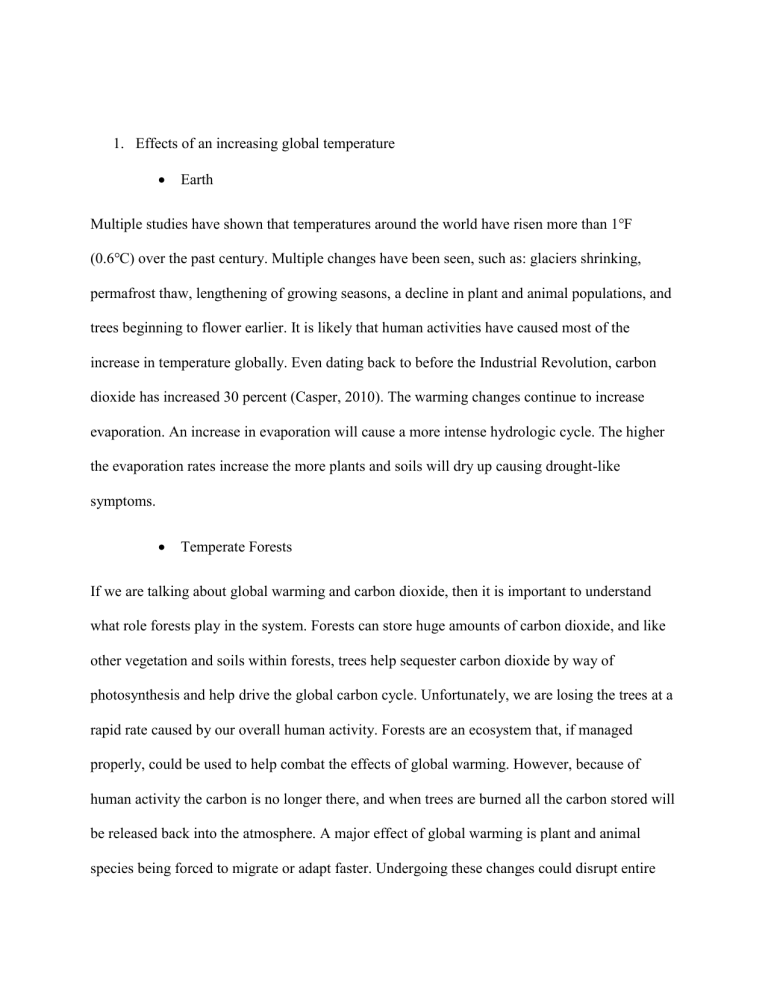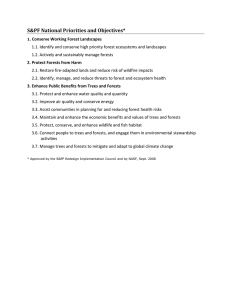
1. Effects of an increasing global temperature Earth Multiple studies have shown that temperatures around the world have risen more than 1℉ (0.6℃) over the past century. Multiple changes have been seen, such as: glaciers shrinking, permafrost thaw, lengthening of growing seasons, a decline in plant and animal populations, and trees beginning to flower earlier. It is likely that human activities have caused most of the increase in temperature globally. Even dating back to before the Industrial Revolution, carbon dioxide has increased 30 percent (Casper, 2010). The warming changes continue to increase evaporation. An increase in evaporation will cause a more intense hydrologic cycle. The higher the evaporation rates increase the more plants and soils will dry up causing drought-like symptoms. Temperate Forests If we are talking about global warming and carbon dioxide, then it is important to understand what role forests play in the system. Forests can store huge amounts of carbon dioxide, and like other vegetation and soils within forests, trees help sequester carbon dioxide by way of photosynthesis and help drive the global carbon cycle. Unfortunately, we are losing the trees at a rapid rate caused by our overall human activity. Forests are an ecosystem that, if managed properly, could be used to help combat the effects of global warming. However, because of human activity the carbon is no longer there, and when trees are burned all the carbon stored will be released back into the atmosphere. A major effect of global warming is plant and animal species being forced to migrate or adapt faster. Undergoing these changes could disrupt entire ecosystems. Researchers had predicted that forests will change with frequency and intensity of fires. It has also been stated that the forest ecosystem will become more disturbed by extreme weather (Casper, 2010). On a severe scale, an increase in temperature globally would cause slow growing plant species to be overrun by fast growing or invasive species. Plant species would migrate both in latitude and elevation. This is a major negative impact on biodiversity and several regions of the world. The most vulnerable forest biomes may disappear forever. 2. Global temperature increases effects on food webs in terrestrial forest regions These ecosystems must supply the needs for the organisms who reside there. Resources like food, water, appropriate temperature, oxygen, and minerals. Temperature increasing would mean a more scarcity in water supplies negatively impacting the plants and animals because it would allow them time to adjust. Global warming is having a great impact on these forest ecosystems because the different species are unable to adapt or survive the changes creating the potential to become extinct. Once an animal leaves a food chain, the impact is will be felt throughout the chain as other species attempt to adjust not only to warmer temperatures but also to the other physical and chemical effects of global warming. Warming conditions can affect both flora and fauna in a food web (Casper, 2010). Plants Animals and humans 3. Global warming increasing the risk of fires Temperate forests have been maintained by frequent, low-severity fires for many years until the implementing of the fire suppression policy. The increasing temperature puts the forests at risk of uncontrollable burns that could devastate the ecosystem. Carbon stocks are at risk due to the fires and the fire suppression policy is said to have contributed to growth in forest carbon stocks. Fire suppression in these forests has led to an ingrowth of trees that would seem to lead to larger carbon stocks. In some temperate forests, reducing the number of large trees results in the reduction of carbon stored (Hurteau et al., 2011). As previously stated, the increase in temperature causes the vegetation and plants to become dry. This ultimately allows for the higher risk of uncontrollable fires in forests just from heat alone. 4. Forest fire effects The increase in greenhouse concentrations will not only be caused from the warming of Earth’s surface, but also accompanied by changes in precipitation patterns and climate variability. Some plant species have adapted to a variety of environmental conditions that have already occurred, such as the timing and severity of fires. However, some species may not be ale to continue to adapt to a new climatic regime if the conditions become greater than the tolerances that have already been created (Veblen et al., 2003). The results of forest fires can have a cascading effect on the distributions of plant species and could affect biotic diversity and ecosystem function. A major issue as a result of climate change is the possible increase in frequency and size of wildfires. This is seen as a big problem because of the complex existing challenges we face today. These changes to wildfires can foster important consequences like species composition, structure of vegetation and native plant diversity. Our climate is the driving force for how wildfires burn across a wide set of temporal variations. The temperature, precipitation, and humidity affect the burning of wildfires by creating the overall moisture levels in vegetation and also the levels of heat transfer needed for igniting the fuel. On a shorter time scale, climate variability can have an impact on droughts and on the duration of wildfire season. These shorter seasons allow for fewer opportunities of wildfires occurring which influences the frequency at a location. Climate on longer time scales can change the overall fire regimes by manipulating the distribution of plants, and growth rates. The changing climate could impact the changes in types of vegetation and changes in other associated fuels which would create a change in the patterns of occurrences and spread of fires. These changes may directly affect the frequency and severity of wildfires which could alter the vegetation in that area (Veblen et al., 2003). Tolerances to environmental factors such as temperature, moisture, light, and nutrients differ between plant species and typically there is a minimum and/or maximum; many species are likely competing for resources. Changes in environmental factors that may exceed a tolerance level of a species could result in them becoming locally extinct in that region. These changes could even cause an imbalance in competitive species resulting in an increase of one species over another. These climate change disturbances foster the establishment for new plants depending on the species ability to take advantage of new environmental conditions. The rate to which the vegetation species respond to the changes in climate could be accelerated by an increase in fire occurrence. This results in a response to climate change dependent on species present, site conditions, and creation of sites by environmental disturbances (Veblen et al., 2003). 5. Forest fire effects on the atmosphere Increasing temperatures, droughts, and large wildfires have caused large disturbances in temperate forests across the globe. These disturbances have caused forest diebacks far beyond what has been previously researched. These changes, also called mega disturbances, can worsen and as a result could lead to huge amounts of carbon being released into the atmosphere. An increase of carbon in this proportion could cause an exacerbation of human health issues and degrade the goods and services we receive from the ecosystem (Fischer et al., 2018). In the United States, because temperate forests inhabit about 40 percent of the land a temperature increase and precipitation decrease could alter the functions of temperate forests and the people would feel those affects. The people living within those forest areas would directly be exposed to those changes in climate and depending on the community there could be a higher sensitivity to ecological changes and hazards because of proximity or reliance on the biome. The increase of wildfires caused by climate-related changes may require changes to be made to the management of forests and other economic and social activities. Certain areas may have the ability to adapt but others might possibly lack the resources or information needed to find alternative solutions of improving economic and social activities. These areas that could be largely impacted are cities where there is a low per capita income, a persistent poverty, high rates of unemployment, and a constant dependance on public and government services. The increase of wildfires could the people in these cities at risk for stress, diseases, allergies, air pollution, and extreme weather. Even more dependent on the forests, indigenous populations would face more difficulty adapting because they have a more limited ability to relocate (Fischer et al., 2018). Several of Earth’s regions are incredibly prone to high occurrences of wildfires. Knowing this, we need to learn better possibilities for coexisting with fire aside from the already implemented fire suppression policy. The cost for this suppression policy has greatly increased and the negative impacts of wildfires are reaching epidemic heights. Furthermore, many of the world’ s ecosystems and their inhabitants are dependent on fi re for their continued existence. (Scott, 2014). Ecosystems net productivity and vegetation structure and dynamics can be directly driven by the effects of climate change. Fires play the major role in the disturbance regime. A shift in this regime can causes permanent changes to the composition of plant species communities, and the function of nutrient, water, and carbon cycles (Loustau, 2010). The interactions between forests, fire, and carbon are cyclic. A forest tree will die after a disturbance, in this case a fire, replacing old growth with new growth. If this cycle is sustained, then there is no net carbon change within the carbon cycle of that forest. The fire will consume about 10 to 20 percent of the carbon produced but emits it back into the atmosphere immediately. The fire will kill the trees, but it does not consume them. As the new trees grow, they begin storing carbon, as the old trees decompose, they are emitting carbon into the atmosphere, and as the organic layer of soil accumulates it also stores carbon. This balance determines if the forest is considered a net source or if it is a carbon sink. Directly following a fire, the carbon released is dissipated into the atmosphere through the combustion process. These fires kill the living biomass and the possible carbon gains are reduced to almost nothing. The strongest effects on the cycling of carbon are the changing of subsequent decomposition and carbon gains through new vegetation growth (Ryan, 2010). While the dead biomass is undergoing decomposition post-fire, it can release three times the amount of carbon that was lost in the combustion during the fire. While this is happening, the carbon lost will begin to exceed the accumulating carbon in regrowth. The forest will continue to grow, and decomposition will end, and then the carbon storage in the trees will catch up and the balance will get closer to zero (Ryan, 2010). In some areas of the world, dominant species dealing with climate change may not be affected as drastically as others in areas with higher moisture levels. However, in more extreme situations certain species will not undergo the development of leaves, affecting their flammability since there will be a lower water content and more energy content (Loustau, 2010). A prolonged drought could also have serious implications on the total or partial death of species and be an addition to dead material. In order for there to be positive feedback, the trees would need to adapt to the availability of water which would limit their death and stress from insufficient water source (Loustau, 2010).




